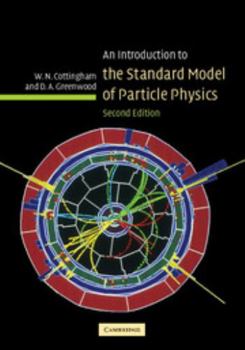An Introduction to the Standard Model of Particle Physics
Select Format
Select Condition 
Book Overview
The second edition of this introductory graduate textbook provides a concise yet accessible introduction to the Standard Model. It has been updated to account for the successes of the theory of strong... This description may be from another edition of this product.
Format:Hardcover
Language:English
ISBN:0521852498
ISBN13:9780521852494
Release Date:March 2007
Publisher:Cambridge University Press
Length:294 Pages
Weight:1.50 lbs.
Dimensions:0.8" x 6.9" x 9.8"
Customer Reviews
5 ratings
Review for An Intoduction to the Standard Model of Particle Physics
Published by Thriftbooks.com User , 16 years ago
According to my opinion this book is well written and well organized and also quite short so that you are not lost in details.
Updated New Edition
Published by Thriftbooks.com User , 17 years ago
In this second edition the authors have upgraded their book to incorporate recent discoveries in several areas including: o the successes of the theory of strong interactions o the observations on matter-antimatter asymmetry o advances in neutrino physics, especially as it has become clear that neutrinos are not mass-less o the theoretical concepts from the electromagnetic and weak interactions of leptons and quarks to the strong interactions of quarks. The book is aimed at the graduate student in particle physics. It has a rigorous mathematical structure. After all, the Standard Model is basically a mathematical theory that describes the interactions between leptons and quarks. Throughout the book there are many references to open questions that likewise reflect the state of the Standard Model.
workout with the Standard Model lagrangian
Published by Thriftbooks.com User , 18 years ago
This book is about the experimental facts and the theoretical principles that lead to the construction of the Standard Model lagrangian. It is NOT about calculating scattering crossections. Some of the problems ask you to calculate decay rates but only at tree level and the fields are treated like classical fields not operators, with the exception that the fermionic fields anticommute. There is a 12-page chapter on quantizing the fields and renormalization but I find it rather sketchy so don't expect to understand a lot from it if you don't already know it. You should have some background in varying lagrangians otherwise the book will frequently seem difficult to you. The authors obtain symmetry currents corresponding to a symmetry of the lagrangian not in the standard way of Noether's theorem. Their method is entirely correct but it took me long time to understand because they didn't explain it with enough details the first time they used it (section 7.1, page 65). I think that will throw off the horse many readers. The style is wonderfully concise which makes the logical structure easier to follow and there isn't the usual fluff `to motivate' things that are simply put guesses like the principle of local gauge invariance. On the other hand, some places definitely need more detailed explanations like signs of certain quantities or the symmetry currents I mentioned above. The treatment of the Dirac equation and spinors is the least messy I've seen. The way they obtain the nonrelativistic limit of the Dirac equation with EM field is again the best and least messy I've seen. The book has nice appendix on the groups of the Standard Model which covers what you need to know about SO(3), SU(2) and SU(3) in a very efficient way. There are about 5 problems after each chapter most of which have a solution outline at the end of the book. Things I understood from this book: -- why time reversal, space inversion and charge conjugation of fields are defined in a way that previously seemed to me quite arbitrary -- how demanding local gauge invariance necessitates introduction of gauge fields which leads to interaction terms -- how local gauge invariance can't be proven, it's just a guess that has worked so far hence it's called `principle' (my own interpretation) -- global and local symmetry breaking, Goldstone bosons and Higgs boson -- how the Lagrangian densities of the electroweak and strong interactions were constructed from the experimental input by demanding local gauge invariance and guessing the symmetry group to be SU(2) and SU(3) correspondingly -- what's Kobayashi-Maskawa matrix that mixes the quark fields and how it arises -- how symmetries of the lagrangian density lead to conservation numbers -- how neglecting some terms in the lagrangian leads to effective lagrangian and effective theory -- how to work with the terms in the QCD lagrangian where different matrices multiply different indices
Excellent Introduction to Particle Physics
Published by Thriftbooks.com User , 22 years ago
This book is an excellent introduction to particle physics. The chapters are short, clear and very readable. As the previous reviewer mentioned, there are a series of reasonable exercises at the end of each chapter with answers provided in the back of the book. Many concepts that field theory or particle physics books leave mysterious or have a difficult time explaining are clearly laid out in this book. I would judge it superior to Griffiths particle physics book, and if you are looking for a nice supplement to serious study of quantum field theory, this is it.
An excellent introduction to particle physics
Published by Thriftbooks.com User , 22 years ago
This is indeed an excellent book in particle physics. It will serve as a good introduction to gauge fields of particle physics.The book is very readable and does not assume more than undergraduate physics. Each chapter ends with a set of problems with solution at the end of the book. It contains a lot of material which can be learned in a short time. I strongly recommend it for a beginner.




